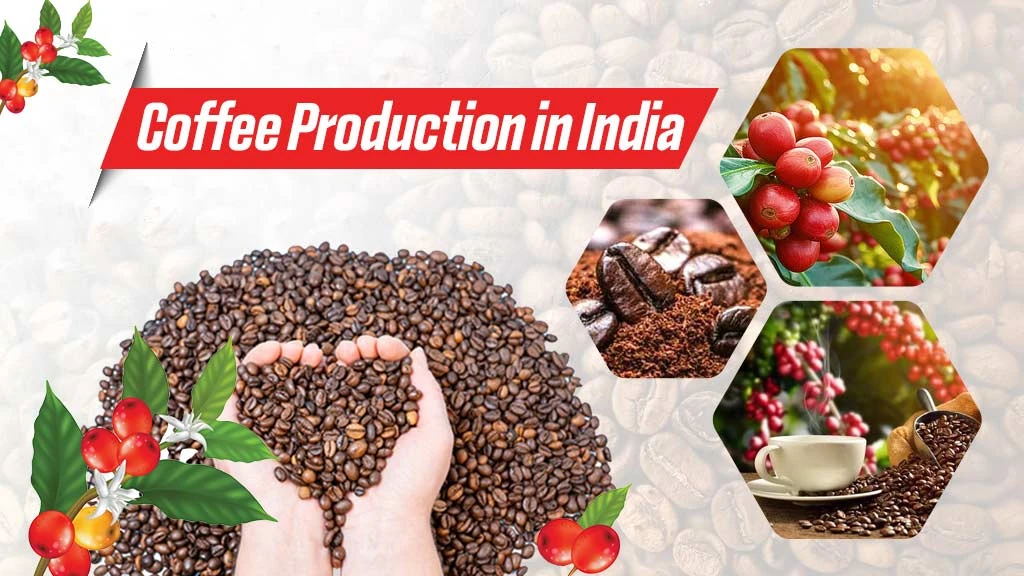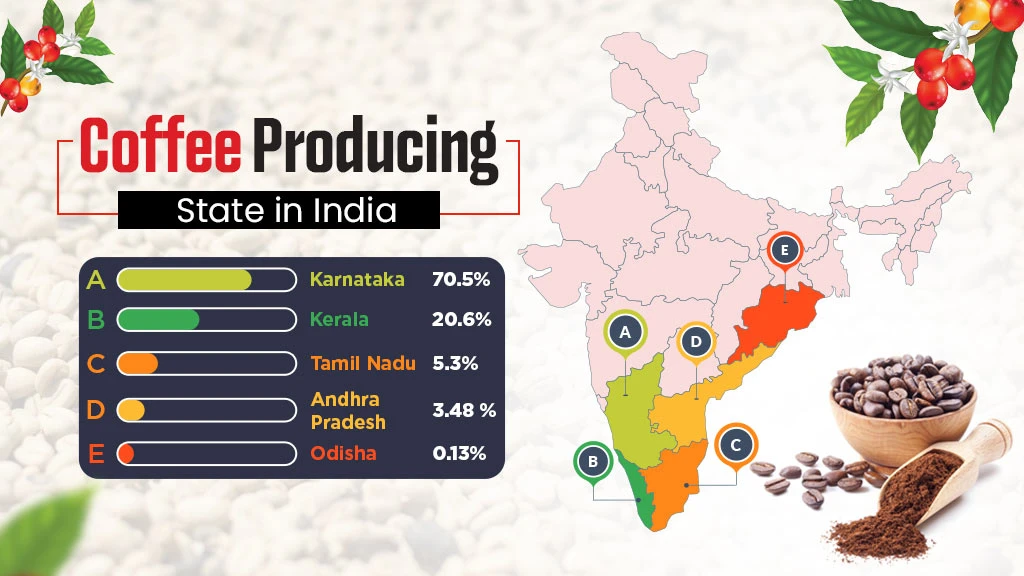Coffee Production in India – Growing Conditions, Types and Top Coffee Producing States

Table of Contents
- Coffee Plantation in India
- What are the Popular Coffee Varieties Found in India?
- Growing Conditions of Coffee in India
- Why Shades are Important for Coffee Production in India?
- What are the Major Coffee Producing States in India?
- What are the Future Prospects of Coffee Plantation in India?
Coffee Plantation in India
Coffee plantations in India on a commercial scale began in the 18th century during British rule. But coffee history in India dates back to 1600 AD when the legendary saint Babu Budan planted "seven seeds" of "mocha" from Yemen in the Chandragiri hills of Karnataka.
Today, India is the world's seventh largest producer of coffee, with 3.7 lakh tonnes of global coffee production. India is the only country where coffee is cultivated under shade; its coffees are the best shade-grown mild coffees in the world.
Coffee is an important cash crop in India that provides direct employment to 2 million people and contributes to remote hilly areas' social and economic development.
Further, coffee is an important export commodity, and according to FAO Statistics, India was the 8th largest exporter of coffee by volume in 2021-22. India exports 70% of its coffee, and Robusta coffee beans are the major exports. The export of Indian coffee was valued at US 1.29 billion dollars in 2023-24. By the half of January 2025, India exported more than 9,300 tonnes of coffee. The major buyers are Italy, Belgium, and Russia.
What are the Popular Coffee Varieties Found in India?
India produces two varieties of coffee, namely Arabica and Robusta. Let us understand these two coffee plants in India through a table.
|
Arabica Coffee |
Robusta Coffee |
|
It has a mild aromatic flavour as the caffeine content is less. |
It has a bitter, strong flavour, and the caffeine content is high. |
|
They are susceptible to pests and disease. |
They are less prone to pests and disease. |
|
The Arabica coffee tree grows sufficiently in height; thus, it requires more shade and greater altitude to grow. |
The Robusta coffee trees grow less in height; thus, they require relatively less shade and less elevation to grow. |
|
It has a high market value but cannot be used to make various blends. |
It is used to make various blends, like instant coffee. |
|
Its share in the export basket is relatively less. |
It forms the major share of coffee exports from India. |
|
Middle East is the main market for Arabica coffee. |
Europe is the main market for Robusta coffee. |
|
Its share in total production in 2022-23 is 28%. |
Its share in total production in 2022-23 is 72%. |
The government of India has given Geographical Indication (GI) to 5 varieties of Indian coffee, which are:
- Coorg Arabica coffee
- Wayanaad Robusta coffee
- Chikmagalur Arabica coffee
- Araku Valley Arabica coffee
- Bababudangiris Arabica coffee
Growing Conditions of Coffees in India
Coffee plantation is an important crop for plantation agriculture in India. The climatic conditions for coffee in India vary depending on the variety of coffee cultivated. The requirements for growing the best coffee beans in India are:
|
Growing Conditions |
Arabica |
Robusta |
|
Soil |
Deep, fertile, well-drained, rich in organic matter, and slightly acidic, with a pH value of 6 – 6.5. |
Same as Arabica |
|
Temperature |
Arabica coffee requires a cool and equitable temperature of 15 – 20°C. |
Robusta requires hot and humid temperatures of 20 – 30 °C. |
|
Rainfall |
An annual rainfall between 1600 mm and 2500 mm is adequate for Arabic coffee. |
Robusta coffee requires a yearly rainfall of 1000 – 2000 mm. |
|
Altitude |
Regions with a high elevation of 1000 – 1500 m are ideal for cultivating Arabica. |
Regions with an elevation of 500 – 1000 m are suitable for cultivating Robusta coffee. |
Why Shades are Important for Coffee Production in India?
Apart from climate and soil requirements, the most essential growing condition for coffee in India is the availability of adequate shade. It is because:
- They help control soil erosion on sloppy terrains.
- They recycle the nutrients from deeper layers, enriching the soil.
- They protect coffee plants from fluctuations in temperature.
- Inter-cropping is possible in these shades; thus, coffee plantations are home to the rich spices of India.
- They also help preserve diverse flora and fauna.
That is why India grows all its coffee under a two-tier mixed shade canopy of evergreen leguminous trees. Coffee plantations consist of about 50 different types of shade trees.
What are the Major Coffee Producing States in India?

|
States |
Total Production in 2022-23 (MT) |
Main Regions |
Share in Total Production (%) |
|
Karnataka |
2.48 lakhs |
Chickmaglur, Kodagu (Coffee capital of India), Hasan |
70.5 |
|
Kerala |
72.5 thousand |
Wayanad, Travancore, Nelliampathies |
20.6 |
|
Tamil Nadu |
18.70 thousand |
Pulneys, Nilgiris, Salem, Coimbatore |
5.3 |
|
Andhra Pradesh |
12.26 thousand |
Araku Valley |
3.48 |
|
Odisha |
465 |
Koraput, Rayagada, Kandhamal |
0.13 |
|
North-East States |
125 |
|
|
What are the Future Prospects of Coffee Plantation in India?
India is the third largest producer and exporter of coffee in Asia. Globally, India is the 7th largest producer and 8th largest exporter of coffee. In 2023, India's coffee market size was estimated to be 1.81 billion US dollars, as per Stellar Market Research.
At present, coffee plantations in India are limited to the Western and Eastern Ghats states, such as Karnataka, Kerala, and Tamil Nadu. These three states together account for 96% of the country's total coffee production. Further, 70% of the coffee produced in the country is exported, and only 30% is consumed domestically.
With the increased demand for coffee and its growing popularity among youths, the coffee market size is expected to increase to 2.43 billion US dollars by 2030, according to Stellar Market Research. Further, the Coffee Board of India has emphasized organic coffee production to meet the demand for chemical-free coffee beans.
Thus, there is a vast scope for coffee plantations in India, and the Indian government must take steps to increase coffee production by enabling its spread in the Northeast region.
Frequently Asked Questions On Coffee Production in India – Growing Conditions, Types and Top Coffee Producing States
1. Which state has the highest coffee production in India?
Karnataka is the largest producer of coffee in India, with a share of 70%.
2. What is India's rank in coffee production?
India is the seventh largest producer of coffee in the world.
3. Which is the coffee capital of India?
Coorg, officially known as Kogadu, is the coffee capital of India.
4. Which soil is found suitable for growing coffee in India?
Laterite soil is found suitable for growing coffee in India.
5. How many types of coffee are produced in India?
In India, two varieties of coffee are produced: Arabica and Robusta.
6. Which state is known as the coffee bowl of India?
Karnataka is known as the coffee bowl of India.
7. Who invented Coffee in India?
Baba Budan is associated with bringing seven beans of coffee from Yemen and planting them in the Chandragiri hills of Karnataka.


Related Blogs















